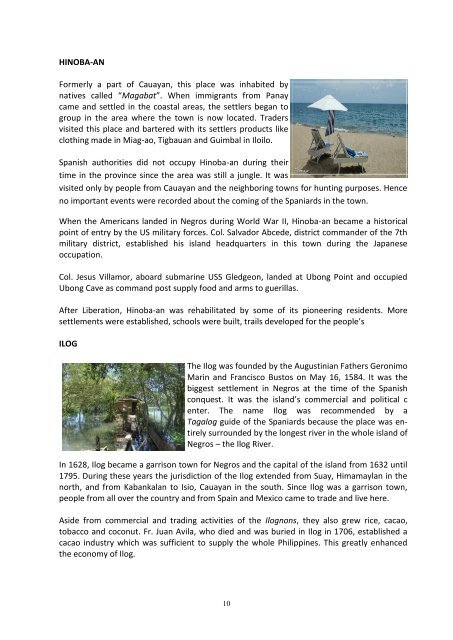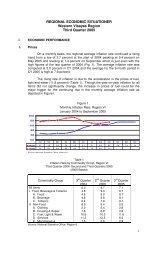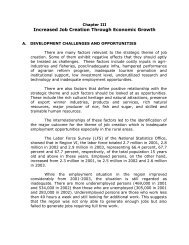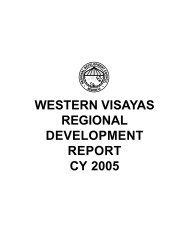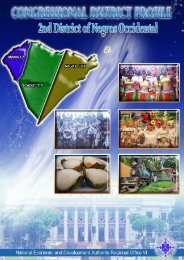Health - NEDA-RDC VI
Health - NEDA-RDC VI
Health - NEDA-RDC VI
Create successful ePaper yourself
Turn your PDF publications into a flip-book with our unique Google optimized e-Paper software.
HINOBA-AN<br />
Formerly a part of Cauayan, this place was inhabited by<br />
natives called “Magabat”. When immigrants from Panay<br />
came and settled in the coastal areas, the settlers began to<br />
group in the area where the town is now located. Traders<br />
visited this place and bartered with its settlers products like<br />
clothing made in Miag-ao, Tigbauan and Guimbal in Iloilo.<br />
Spanish authorities did not occupy Hinoba-an during their<br />
time in the province since the area was still a jungle. It was<br />
visited only by people from Cauayan and the neighboring towns for hunting purposes. Hence<br />
no important events were recorded about the coming of the Spaniards in the town.<br />
When the Americans landed in Negros during World War II, Hinoba-an became a historical<br />
point of entry by the US military forces. Col. Salvador Abcede, district commander of the 7th<br />
military district, established his island headquarters in this town during the Japanese<br />
occupation.<br />
Col. Jesus Villamor, aboard submarine USS Gledgeon, landed at Ubong Point and occupied<br />
Ubong Cave as command post supply food and arms to guerillas.<br />
After Liberation, Hinoba-an was rehabilitated by some of its pioneering residents. More<br />
settlements were established, schools were built, trails developed for the people’s<br />
ILOG<br />
The Ilog was founded by the Augustinian Fathers Geronimo<br />
Marin and Francisco Bustos on May 16, 1584. It was the<br />
biggest settlement in Negros at the time of the Spanish<br />
conquest. It was the island’s commercial and political c<br />
enter. The name Ilog was recommended by a<br />
Tagalog guide of the Spaniards because the place was entirely<br />
surrounded by the longest river in the whole island of<br />
Negros – the Ilog River.<br />
In 1628, Ilog became a garrison town for Negros and the capital of the island from 1632 until<br />
1795. During these years the jurisdiction of the Ilog extended from Suay, Himamaylan in the<br />
north, and from Kabankalan to Isio, Cauayan in the south. Since Ilog was a garrison town,<br />
people from all over the country and from Spain and Mexico came to trade and live here.<br />
Aside from commercial and trading activities of the Ilognons, they also grew rice, cacao,<br />
tobacco and coconut. Fr. Juan Avila, who died and was buried in Ilog in 1706, established a<br />
cacao industry which was sufficient to supply the whole Philippines. This greatly enhanced<br />
the economy of Ilog.<br />
10


